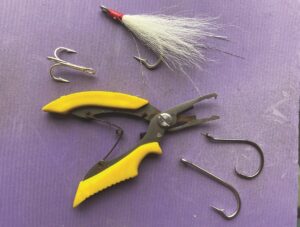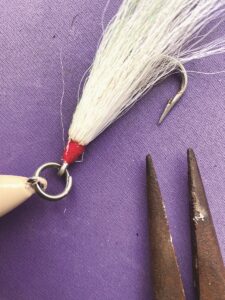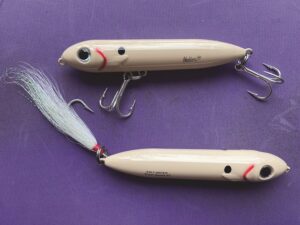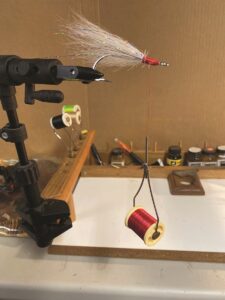The last time I used anything more than a single hook while fishing was a memorable mid-September day in 1978, when an enormous school of 15-pound bluefish cornered an even larger school of menhaden at Mayo Beach, from Wellfleet’s town pier to the yacht club.
The blitz lasted for hours, resulting in an elbow-to-elbow line of people — it would be a stretch to call them all fishermen — casting everything from freshwater trout rods to baited hooks attached to clotheslines. The menhaden were so thick along the shore that they suffocated, leaving a thick carpet of dead fish (and bait) on the beach as the tide receded. Find anyone in town who witnessed that spectacle and they’ll tell you with hushed awe that they still remember the Great Mayo Beach Bluefish Blitz.

Not all the carnage was piscatorial. The crowd’s lack of proper gear and experience meant endless entanglements in crossed fishing lines. Many first-timers at handling large toothy bluefish (they’re nicknamed “choppers” for a reason) ended up with gashed fingers and treble-hook lures dangling from their appendages, waiting for attention at the old AIM medical clinic on Route 6.
A preteen boy landed a huge bluefish right in front of me, which his nonfishing grandfather insisted on dehooking. He made the mistake of trying to remove the large double-treble hook lure before subduing the wildly flopping fish. By the time I got to him the second set of hooks had become buried in the flesh at the base of his thumb, while the first set remained firmly in the fish’s mouth. It seemed like an eternity before I was able to grab the bluefish properly, during which the treble hooks went deeper into his palm. I still get the heebie-jeebies thinking about it.

Since then, my spring pre-fishing ritual starts with replacing all my lost, mangled, or rusted lures and plugs and then removing all the treble hooks that come with new lures. There is simply no reason to use a treble hook, in my opinion.
Besides doing terrible damage to fish mouths, eyes, and gills, they are far more difficult to unhook than the single barbless hooks I replace them with.
If one set of treble hooks is problematic, two sets of treble hooks are doubly so. If their makers’ promise is more hook-ups and fewer dropped fish, it’s a lie. In fact, hooking a fish with two sets of trebles is a liability, as one set will invariably detach, instantly creating a new line angle resulting in the remaining treble coming free.
On my first visit to Goose Hummock in Orleans this spring, I was pleased to see about a third of the manufacturers are now making lures with only single tail hooks. That’s great, but it’s not enough.
Spin fishing with lures is its own art form, but one that still has much to learn from fly fishing. In most blue-ribbon trout streams around the world, fishermen are allowed to use only a single barbless hook. A hook’s barb, every fly fisherman knows, doesn’t affect fishing success.

The secret to successful fishing is knowing when and where to find the fish. And landing any fish, large or small, fresh water or salt, depends on keeping steady, even tension as the line is retrieved.
Most fish can be released from a barbless hook without having to be grabbed or even removed from the water. And with increasing regulation, most stripers you catch these days must be released. The legal length of a “keeper” is between 28 and 35 inches.
Two years ago, when most of the stripers were juveniles, only one out of a hundred were keepers, especially for those fishing from the beach rather than from a boat. Using fish-friendly gear means more fish and bigger fish a year or three down the line.

Beginning with the 2020 season, fisheries regulators outlawed the use of regular straight-shanked bait hooks in favor of circle hooks. Their unique shape prevents almost-always-fatal stomach hookups. Why regulators still permit barbed treble hooks says more to me about the power of fishing capitalism to shape regulations than it does about commonsense fishing.
The hardest piece of gear to find is the large bucktail hook. In my book, bucktails are the best way of getting a fish’s attention because they mimic perfectly the action of a fish’s tail. They are expensive and are also rare commodities in tackle shops, so I’ve taken to buying deer tails and unadorned hooks (both available online at places like Bass Pro Shops). For less than a dollar apiece I tie them up and pinch their barbs as I finish. I make them by the dozen.
I like having these bucktails ready to hand out when I meet fellow enthusiasts and discover they’re still using those odious barbed treble hooks. I hope I come off looking more like the Johnny Appleseed of fishing than the anti-treble-hook ranter I really am.



